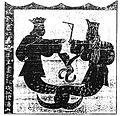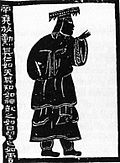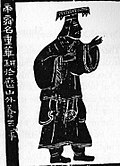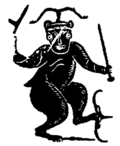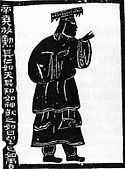Tři vznešení a pět vladařů
| Čína v době Tří vznešených a pěti vladařů 三皇五帝
| ||||||
Geografie
| ||||||
| Obyvatelstvo | ||||||
staročínština, čínské jazyky | ||||||
| Státní útvar | ||||||
| Státní útvary a území | ||||||
| ||||||
 | |||||||
|---|---|---|---|---|---|---|---|
| STAROVĚKÁ ČÍNA | |||||||
| 3 vznešení a 5 vladařů | |||||||
| Dynastie Sia 2100–1600 př. n. l. | |||||||
| Dynastie Šang 1600–1046 př. n. l. | |||||||
| Dynastie Čou 1045–256 př. n. l. | |||||||
| Západní Čou | |||||||
| Východní Čou | |||||||
| Období Jar a podzimů | |||||||
| Období válčících států | |||||||
| CÍSAŘSKÁ ČÍNA | |||||||
| Dynastie Čchin 221 př. n. l.–206 př. n. l. | |||||||
| Dynastie Chan 206 př. n. l.–220 n. l. | |||||||
| Západní Chan | |||||||
| Dynastie Sin | |||||||
| Východní Chan | |||||||
| Období tří říší 220–280 | |||||||
| Wej, Šu & Wu | |||||||
| Dynastie Ťin 265–420 | |||||||
| Západní Ťin | 16 Království 304–439 | ||||||
| Východní Ťin | |||||||
| Severní & Jižní dynastie 420–589 | |||||||
| Dynastie Suej 581–618 | |||||||
| Říše Tchang 618–907 | |||||||
| ( X Wu Ce-tchien 690–705 ) | |||||||
| 5 dynastií & 10 říší 907–960 | Dynastie Liao 907–1125 | ||||||
| Dynastie Sung 960–1279 | |||||||
| Severní Sung | Z. Sia | ||||||
| Jižní Sung | Ťin | ||||||
| Dynastie Jüan 1271–1368 | |||||||
| Dynastie Ming 1368–1644 | |||||||
| Říše Čching 1644–1911 | |||||||
| MODERNÍ ČÍNA | |||||||
| Republika 1912–1949 | |||||||
| Spor o Čínu ... | |||||||
| Čínská lidová republika 1949–současnost | Čínská republika (Tchaj-wan) 1945–současnost | ||||||
Související články Časová osa čínských dějin | |||||||
Tři vznešení a pět vladařů (čínsky v českém přepisu san-chuang wu-ti, pchin-jinem sān huáng wǔ dì, znaky 三皇 五帝) je skupina mytologických vládců, původně božských či polobožských bytostí, podle tradiční čínské chronologie panujících ve 29. – 21. století př. n. l. Po nich následovala legendární dynastie Sia. Složení obou skupin, třech vznešených i pěti vládců, je v různých starověkých čínských textech odlišné.
Tři vznešení
Mezi tři vznešené (čínsky v českém přepisu san-chuang, pchin-jinem sān huáng, znaky 三皇) vládce byli počítáni:
- Suej Žen, Fu-si, Šen-nung (v Šang-šu ta-čuan, 尚書大傳);
- Fu-si, Suej Žen, Šen-nung (v Li chan-wen-ťia 禮含文嘉, Čchun-čchiou ming-li sü 春秋命歷序);
- Fu-si, Nü Wa, Šen-nung (v Čchun-čchiou jün-tou šu, 春秋運斗樞);
- Fu-si, Ču Žung, Šen-nung (v Li chao-š’-ťi, 禮號謚記);
- Fu-si, Šen-nung, Ču Žung (v Siao-ťing kou-ming ťüe, 孝經鈎命決);
- Fu-si, Šen-nung, Suej Žen (v Paj-chu-tchung, 白虎通);
- Fu-si, Šen-nung a Chuang-ti (Žlutý císař) (v Knize dokumentů).[1]
Poslední varianta, Fu-si, Šen-nung a Chuang-ti je uvedena v předmluvě ke Knize dokumentů, jejíž autorita převážila ostatní zdroje a vedla k obecnému uznání této trojice.[1] V čínských legendách je Třem vznešeným přisuzováno zavedení základních civilizačních dovedností, Fu-si měl vynalézt lov zvěře a ryb, Šen-nung zemědělství a Žlutý císař, praotec chanských Číňanů, zpracování kovů, architekturu a lékařství.[2]
Pět vladařů
Vladařů bylo z většího počtu polobožských a legendárních postav vybráno pět pod vlivem učení o pěti fázích/prvcích. Mezi pět vládců byli řazeni:
- Žlutý císař, Čuan-sü, Kchu, Jao a Šun (v Ta Taj li-ťi 大戴禮記, Š’-pen 世本, Lü-š’ čchun-čchiou 呂氏春秋 a Zápiscích historika),
- Mi-chu (宓戱, či Mi-si 宓戲, tj. Fu-si), Šen-nung, Žlutý císař, Jao a Šun (v Plánech válčících států, Knize proměn, Čuang-c’, Chuaj-nan-c’ 淮南子, San-tchung-li 三統曆),
- Tchaj-chao, Jen, Žlutý císař, Šao-chao, Čuan-sü (v Lü-š’ čchun-čchiou, Knize obřadů, Čchien-fu-lun 潛夫論),
- Šao-chao, Čuan-sü, Kchu, Jao a Šun (v Knize písní, Ti-wang š’-ťi 帝王世紀);
- Žlutý císař, Šao-chao, Čuan-sü, Kchu a Jao (v C’-č’ tchung-ťien waj-ťi 資治通鑒外紀 z 11. století).[1]
Galerie
- Fu-si a Nüwa
- Fu-si a Nüwa
- Šen-nung
- Žlutý císař
- Čuan-sü
- císař Kchu
- císař Jao
- císař Šun
- Ši-ju
Reference
- ↑ a b c THEOBALD, Ulrich. Chinaknowledge – a universal guide for China studies [online]. [cit. 2014-04-15]. Kapitola Chinese History - The Three Augusts and Five Emperors 三皇五帝. Dostupné online. (anglicky)
- ↑ LIŠČÁK, Vladimír. Konfuciánství od počátků do současnosti. 1. vyd. Praha: Academia, 2013. 468 s. ISBN 978-80-200-2190-8. S. 377.
Externí odkazy
 Obrázky, zvuky či videa k tématu Tři vznešení a pět vladařů na Wikimedia Commons
Obrázky, zvuky či videa k tématu Tři vznešení a pět vladařů na Wikimedia Commons
Média použitá na této stránce
No official flag.
Chi You. The stone print of the age of Han dynasty.
Shennong, the Farmer God, with his plow. Inscription reads: 'The Farmer God taught agriculture based on land use; he opened up the land and planted millet to encourage the myriad people (Birrell, Chinese Mythology, ISBN 0-8018-6183-7, p.48)
"Departure Herald", 26 m (85 ft) in length, from the Chinese Xuande reign period (1425-1435 AD); the painting shows the emperor's large procession heading towards the imperial tombs of the Ming emperors located roughly 50 km north of the capital Beijing. This painting is usually paired with another panoramic painting called "Return Clearing", 30 m (98 ft) in length, which shows the emperor returning to the capital from the tombs by river boat. From Paludan's source listed below, this passage describes a particular scene of this painting: "Detail of a silk scroll, The Emperor's Approach, showing the luxury in which the emperor Xuande travelled. Elephants were kept in the imperial elephant stables until around 1900 and were often used for ceremonial occasions, such as the emperor's visits to the Temple of Heaven. Here, however, the large number of horsemen accompanying the emperor's carriage suggests that the emperor was on a much longer journey in the countryside." Paludan, Ann. (1998). Chronicle of the Chinese Emperors: the Reign-by-Reign Record of the Rulers of Imperial China. London: Thames & Hudson Ltd. ISBN 0500050902. Page 177.
Emperor Yao, one of the mythical Five Sovereigns. Inscription reads: The God Yao, Fang Xun, was humane like Heaven itself, and wise like a divine being; to be near him was like approaching the sun, to look at him was like gazing into clouds'(Birrell, Chinese Mythology, ISBN 0-8018-6183-7, p.71)
The Yellow Emperor, one of the mythical Five Sovereigns. Inscription reads: 'The Yellow Emperor created and changed a great many things; he invented weapons and the wells and fields system; he devised upper and lower garments, and established palaces and houses' (Birrell, Chinese Mythology, ISBN 0-8018-6183-7, p.48) / The Yellow Emperor, one of the mythical Five Sovereigns. Inscription reads: 'The Yellow Emperor created and changed a great many things; he invented weapons; he divide fields; he devised upper and lower garments, and established palaces and houses' (周家华, translated according to another understanding. )
Autor: SY, Licence: CC BY-SA 4.0
Map of tribes and tribal unions in Ancient China, including tribes of Huang Di (Yellow Emperor), Yan Di (Flame Emperor) and Chiyou.
Emperor Ku, one of the mythical Five Sovereigns. Inscription reads: 'The God Ku, Gao Xin, was the great grandson of the Yellow Emperor.' (Birrell, Chinese Mythology, ISBN 0-8018-6183-7, p.48)
Emperor Shun, one of the mythical Five Sovereigns.Inscription reads: The God Shun, Zhong Hua, plowed beyond Mount Li; in three years he had developed it (Birrell, Chinese Mythology, ISBN 0-8018-6183-7, p.71
Zhuanxu, one of the mythical Five Sovereigns. Inscription reads: 'The God Zhuanxu, Gao Yang, was the grandson of the Yellow Emperor and the son of Chang Yi' (Birrell, Chinese Mythology, ISBN 0-8018-6183-7, p.48)

